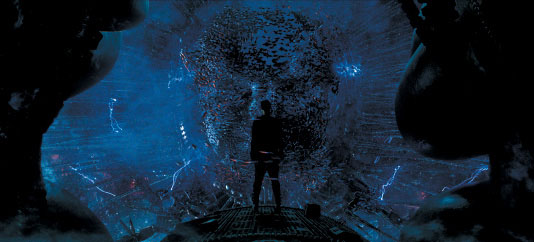“Tippett Studio Creates Machine City in “The Matrix: Revolutions”” by Wachowski and Wachowski
Conference:
- SIGGRAPH 2004 More animation videos from SIGGRAPH 2004:


SIGGRAPH Video Review:
Track:
- 19
Title:
- Tippett Studio Creates Machine City in “The Matrix: Revolutions”
Length:
- 3:30
Director(s):
Company / Institution / Agency:
- Tippett Studio
Description:
Guided by Tippett Studio senior visual effects supervisor, CraigHayes, Tippett Studio created the Machine City sequence by building not only a vast, living, breathing cityscape environment, but also its varied menagerie of machine inhabitants. The city, envisioned as a living fractal reef, was twice the size of the Los Angeles basin andalive in every aspect: building itself on the fly, populated with massive swarms of denizens, pulsing with lighting, electrostatic events and atmospherics. Even the massive towers appear sentient in their slow purposeful movements as they track events within the city.
City architecture was laid out both procedurally and by hand, using the building blocks of a component model library to construct organi-cally rich and diverse crustacean-like buildings, all upon the scorched and fractured terrain typical of the Matrix’s real world. Roiling clouds,lightning, electrostatics, ground pollution, and bioluminescence are a few of the 3D environmental elements stretching back 50 miles to the horizon. Dozens of species of denizens were created to inhabit this city, from the very petite to the imposing Machine God, modeled on the Wachowski Brothers’ baby nephew. Each of the 140-plus shots contains at least 25 elements; many contain more than 125.
Hardware:
HARDWARE: PC, Apple, SGI single CPU, average 2 GB RAM. Rendering Farm:
CPU numbers N.A. Graphics card: NVIDIA.
Software:
SOFTWARE DEVELOPER: Modeling, animation, and dynamics: Maya. Rendering: RenderMan.
Compositing: Shake. Custom software: Custom plug-ins, custom
Prman shaders, RIB and RIB Archive generation tools. OS: Various.
Additional Contributors:
Producers: Joel Silver, Grant Hill
Eon Visual Effects Supervisors: John Gaeta, John Des Jardin
TIPPETT STUDIO STAFF
Senior Visual Effects Supervisor: Craig Hayes
Visual Effects Producer: Amy Hollywood Wixson
CG Supervisor: Johnny Gibson
Visual Effects Supervisor: Scott Souter
Art Director: Grant Alan Niesner
Animation Supervisor: Simon Allen
Digital Production Managers: Athena Yvette Portillo, Les G. Jones
Visual Effects Editorial: Sarah Schubart
Animation Leads: Dovi Anderson, Thomas Schelesny
Animators: Michael Brunet, Chuck Duke, Aaron Gilman, Traci Horie, Eric Ingerson, Julie Jaros, Daniel Loeb, Guido Muzzarelli, Jason Shulman
FX Animation Leads: Demetrius Leal, Daniel Rolinek
FX Animators: Eyal Erez, Christopher Lyman Hamilton, Michael Johnson, Clear Menser, Naz Shams, Melissa Tseng, Bryan Whitaker
Lighting Leads: Lloyd Royal Bernberg, Charles Rose
Lighting Technical Directors: Mark Andrew De La Garza, Steven Demers, Brad Fox, Steven Quiñones-Colon, Julien Schreyer, Bart Trickel, Jim Valladao, Kelly Walsh, Matthew Welker, Davy Wentworth, Nelson Andrew White
Compositing Leads: Alan Boucek, Matt Jacobs
Digital Compositors: Dan Cayer, Brennan Doyle, Page Frakes, Chris Gibbons, Aruna Inversin, Jeff A. Johnson, Zoe Peck-Eyler, Gerard Benjamin Pierre, Ari Rubenstein, Josh Saeta, Matthew Wallin
Matte Painter: Kent Matheson
Layout Lead: Christopher Paizis
Layout: Stephen Moros, Mark Siew
Model Lead: Joseph Hamdorf
Model: Jon Childress Farmer, John Koester, Paul Zinnes
Paint Leads: Aaron “Pandacat” Florez, Andy Harbeck
Paint: Nathan Stinus Fredenburg, Haskell Friedman
Puppet Lead: Matthew Muntean
Puppet: Peter Newsome, Tracey Roberts
Matchmove: Devin Breese, Kirk Larkins, Eric Marko
Rotoscope: Robert Dorris, Rick Markle, Ramona Martinez, Misty Segura Barbour, Kenneth Voss
Digital Coordinators: Jaimie Lee Jota, Naomi Ruth Raine
Assistant Digital Coordinator: Christopher Hall
Production Assistants: Lisa Fay, Ron Nichols
Render Wranglers: Christine Gatchalian, Nate Reid
Film I/O: Vicki Wong, Nathan Abbot, Matthew Tomlinson
Production Software Development: Markus Burki, Doug Epps, Michael Mortimer
Head of Operations: Dan McNamara
Director of Systems: Christian Rice
Studio Controller: Suzanne Yoshi
Head of Production: Alonzo Ruvalcaba
Executive Producer: Jules Roman
Additional Information:
PRODUCTION
Modeling: Maya NURBS and polygons to model city component libraries, based upon concept drawings from Geoff Darrow. Some2D rotoscoping used. Rendering technique used most: RenderMan,with extensive use of DelayedReadArchives. This allowed us to easily swap which of several different resolutions of models to actually use at render time. Average rendering CPU time per frame: 6-10 hours.Total production time: 18 months. Production highlight: This completely CG photo-real sequence, with little live-action photography,required building a massive living city. Component libraries of building pieces were built in such a fashion they could be used both procedu-rally or with hand dressing to create a densely layered cityscape that could be shaded either realistically or in a highly stylized manner (asin “neovision”).




